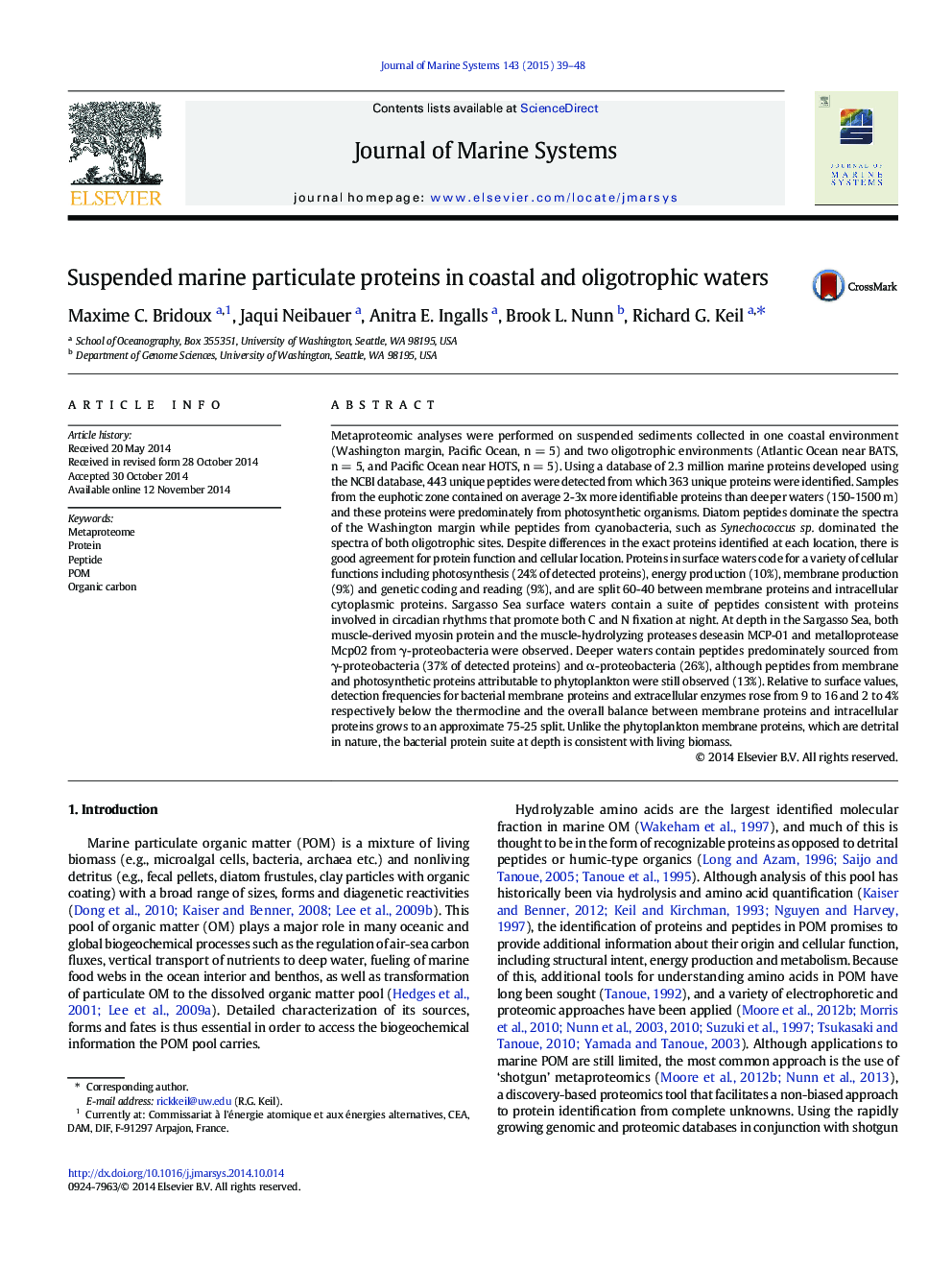| کد مقاله | کد نشریه | سال انتشار | مقاله انگلیسی | نسخه تمام متن |
|---|---|---|---|---|
| 6386749 | 1627286 | 2015 | 10 صفحه PDF | دانلود رایگان |
عنوان انگلیسی مقاله ISI
Suspended marine particulate proteins in coastal and oligotrophic waters
ترجمه فارسی عنوان
پروتئین های ذرات دریایی معلق در آب های ساحلی و الیگوتروفی
دانلود مقاله + سفارش ترجمه
دانلود مقاله ISI انگلیسی
رایگان برای ایرانیان
موضوعات مرتبط
مهندسی و علوم پایه
علوم زمین و سیارات
اقیانوس شناسی
چکیده انگلیسی
Metaproteomic analyses were performed on suspended sediments collected in one coastal environment (Washington margin, Pacific Ocean, n = 5) and two oligotrophic environments (Atlantic Ocean near BATS, n = 5, and Pacific Ocean near HOTS, n = 5). Using a database of 2.3 million marine proteins developed using the NCBI database, 443 unique peptides were detected from which 363 unique proteins were identified. Samples from the euphotic zone contained on average 2-3x more identifiable proteins than deeper waters (150-1500 m) and these proteins were predominately from photosynthetic organisms. Diatom peptides dominate the spectra of the Washington margin while peptides from cyanobacteria, such as Synechococcus sp. dominated the spectra of both oligotrophic sites. Despite differences in the exact proteins identified at each location, there is good agreement for protein function and cellular location. Proteins in surface waters code for a variety of cellular functions including photosynthesis (24% of detected proteins), energy production (10%), membrane production (9%) and genetic coding and reading (9%), and are split 60-40 between membrane proteins and intracellular cytoplasmic proteins. Sargasso Sea surface waters contain a suite of peptides consistent with proteins involved in circadian rhythms that promote both C and N fixation at night. At depth in the Sargasso Sea, both muscle-derived myosin protein and the muscle-hydrolyzing proteases deseasin MCP-01 and metalloprotease Mcp02 from γ-proteobacteria were observed. Deeper waters contain peptides predominately sourced from γ-proteobacteria (37% of detected proteins) and α-proteobacteria (26%), although peptides from membrane and photosynthetic proteins attributable to phytoplankton were still observed (13%). Relative to surface values, detection frequencies for bacterial membrane proteins and extracellular enzymes rose from 9 to 16 and 2 to 4% respectively below the thermocline and the overall balance between membrane proteins and intracellular proteins grows to an approximate 75-25 split. Unlike the phytoplankton membrane proteins, which are detrital in nature, the bacterial protein suite at depth is consistent with living biomass.
ناشر
Database: Elsevier - ScienceDirect (ساینس دایرکت)
Journal: Journal of Marine Systems - Volume 143, March 2015, Pages 39-48
Journal: Journal of Marine Systems - Volume 143, March 2015, Pages 39-48
نویسندگان
Maxime C. Bridoux, Jaqui Neibauer, Anitra E. Ingalls, Brook L. Nunn, Richard G. Keil,
